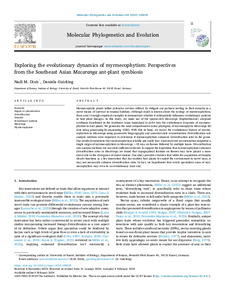Exploring the evolutionary dynamics of myrmecophytism: Perspectives from the Southeast Asian Macaranga ant-plant symbiosis
| dc.date.accessioned | 2024-03-08T13:12:12Z | |
| dc.date.available | 2024-03-08T13:12:12Z | |
| dc.date.issued | 2024-02-09 | |
| dc.identifier | doi:10.17170/kobra-202403089745 | |
| dc.identifier.uri | http://hdl.handle.net/123456789/15544 | |
| dc.description.sponsorship | Gefördert im Rahmen des Projekts DEAL | |
| dc.language.iso | eng | |
| dc.rights | Namensnennung 4.0 International | * |
| dc.rights.uri | http://creativecommons.org/licenses/by/4.0/ | * |
| dc.subject | Degree of specialisation | eng |
| dc.subject | Diversification | eng |
| dc.subject | Domatia | eng |
| dc.subject | Evolutionary patterns | eng |
| dc.subject | Macaranga | eng |
| dc.subject | Myrmecophytism | eng |
| dc.subject.ddc | 580 | |
| dc.title | Exploring the evolutionary dynamics of myrmecophytism: Perspectives from the Southeast Asian Macaranga ant-plant symbiosis | eng |
| dc.type | Aufsatz | |
| dcterms.abstract | Myrmecophytic plants utilise defensive services offered by obligate ant partners nesting in their domatia in a novel means of survival in tropical habitats. Although much is known about the ecology of myrmecophytism, there aren’t enough empirical examples to demonstrate whether it substantially influences evolutionary patterns in host plant lineages. In this study, we make use of the species-rich Macaranga (Euphorbiaceae) ant-plant symbiosis distributed in the Southeast Asian Sundaland to delve into the evolutionary dynamics of myrmecophytism in host plants. We generated the most comprehensive dated phylogeny of myrmecophytic Macaranga till date using genotyping-by-sequencing (GBS). With this in hand, we traced the evolutionary history of myrmecophytism in Macaranga using parametric biogeography and ancestral state reconstruction. Diversification rate analysis methods were employed to determine if myrmecophytism enhanced diversification rates in the genus. Our results demonstrate that myrmecophytism is labile and easily lost. Ancestral state reconstruction supported a single origin of myrmecophytism in Macaranga ~18 mya on Borneo followed by multiple losses. Diversification rate analysis methods did not yield sufficient evidence to support the hypothesis that myrmecophytism enhanced diversification rates in Macaranga; we found that topographical features on Borneo may have played a more direct role in the divergence of clades instead. Our study provides evidence that while the acquisition of domatia clearly functions as a key innovation that has enabled host plants to exploit the environment in novel ways, it may not necessarily enhance diversification rates. In fact, we hypothesise that overly specialised cases of myrmecophytism may even be an evolutionary dead end. | eng |
| dcterms.accessRights | open access | |
| dcterms.creator | Dixit, Nadi Manjunath | |
| dcterms.creator | Guicking, Daniela | |
| dc.relation.doi | doi:10.1016/j.ympev.2024.108028 | |
| dc.subject.swd | Evolutionsbiologie | ger |
| dc.subject.swd | Diversifikation | ger |
| dc.subject.swd | Symbiose | ger |
| dc.subject.swd | Pflanzen | ger |
| dc.subject.swd | Ameisen | ger |
| dc.subject.swd | Südostasien | ger |
| dc.type.version | publishedVersion | |
| dcterms.source.identifier | eissn:1095-9513 | |
| dcterms.source.issue | May | |
| dcterms.source.journal | Molecular Phylogenetics and Evolution | eng |
| dcterms.source.volume | Volume 194 | |
| kup.iskup | false | |
| dcterms.source.articlenumber | 108028 |
Dateien zu dieser Ressource
Das Dokument erscheint in:
-
Artikel [1169]


